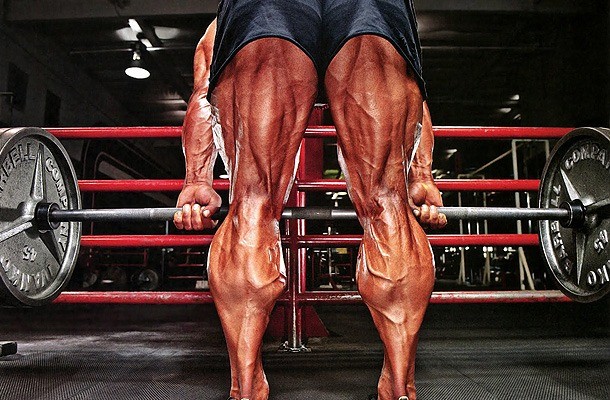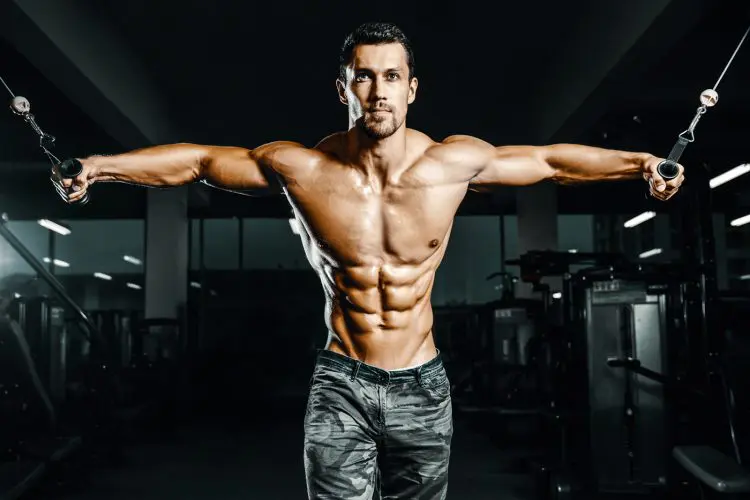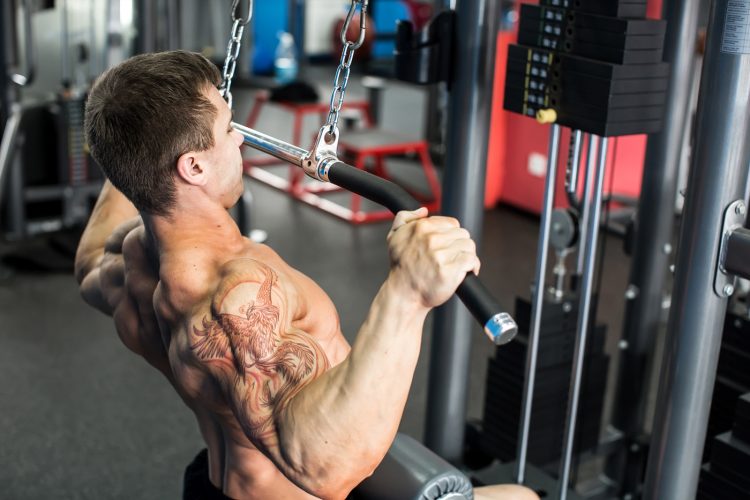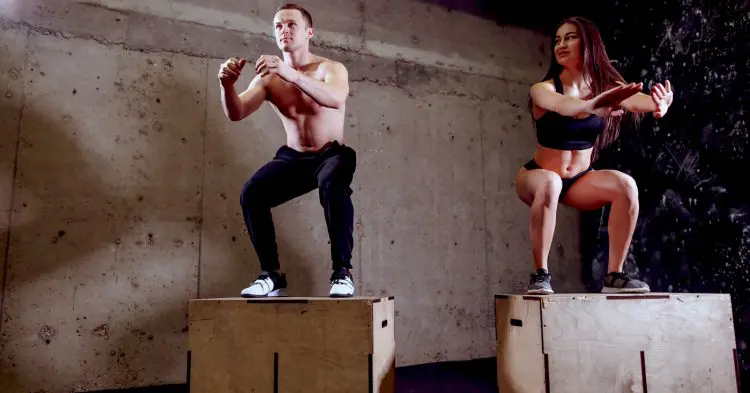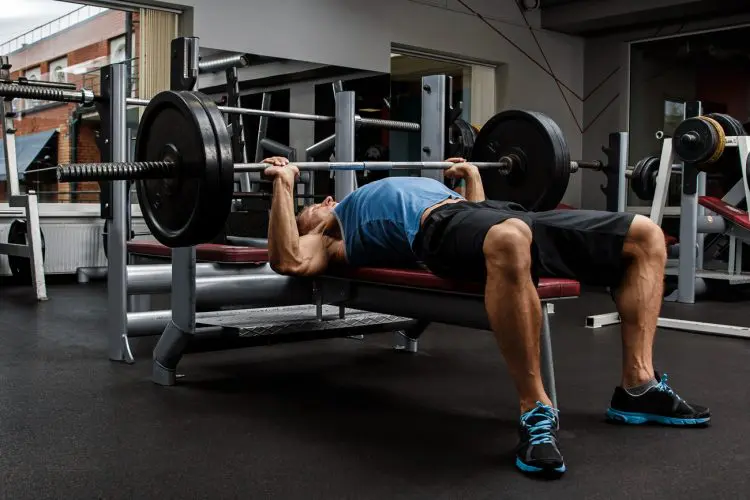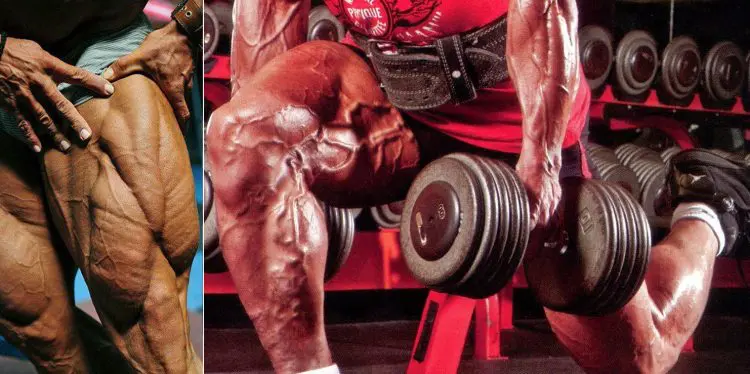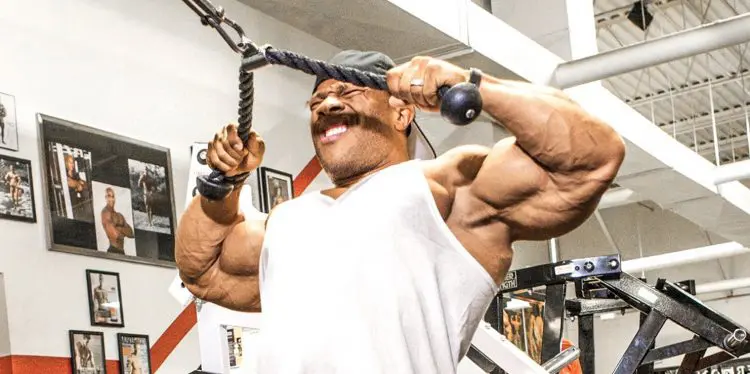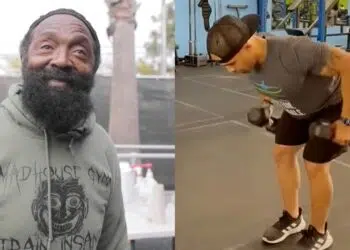The best strength training programs are built around a relatively small number of “big lifts.” These are the exercises that give you the most bang for your buck. Usually compound in nature, these are the exercises that build muscle and strength and produce most of your gains. Examples include:
- Squats
- Bench presses
- Deadlifts
- Overhead presses
- Power cleans
- Pull-ups/chin/ups
- Bent over rows
You’ll also see these exercises described as core lifts, cornerstone lifts, and main lifts.
These exercises are so effective, you could probably build an impressive-looking, powerful physique if you only did these lifts. In fact, a lot of old-school lifters favored such an approach. Think of this as a bare-bones approach to program design.

Your choice of “big” exercises depends on your training goals. Powerlifters will put most of their time and energy into the competitive lifts, i.e., squats, bench presses, and deadlifts. In contrast, a strongman competitor may choose different lifts, such as stone lifting, overhead presses, and farmer’s walks.
The bottom line is that, when it comes to training, your primary focus should be on the exercises that produce the most significant gains in strength or muscle size.
That said, while big compound exercises should form the foundation of your workouts, it’s often useful to include additional exercises to create a more well-rounded program. These secondary movements are often called accessory exercises.
Level Up Your Fitness: Join our 💪 strong community in Fitness Volt Newsletter. Get daily inspiration, expert-backed workouts, nutrition tips, the latest in strength sports, and the support you need to reach your goals. Subscribe for free!
As their name suggests, these exercises usually come after your main lifts and are included for various reasons. In this article, we reveal the uses and benefits of accessory exercises and provide you with a host of examples so you can choose the right ones for your training goals.
What Is an Accessory Exercise?
Accessory exercises are secondary lifts that are included for a variety of reasons. They plug the developmental gaps that can be left by the big lifts. They add an extra dimension to your workouts, increasing training volume, and strengthening any weak links that could lead to injury or reduced performance.
For example, let’s say you usually do squats for your main leg exercise. As good as squats are, they work your quads more than your hamstrings. If you rely on just squats to train your legs, you may end up with big quads, but underdeveloped hamstrings. Weak hamstrings could undermine your squat performance.
Subsequently, as well as squats, you may include Romanian deadlifts in your workouts to increase hamstring size and strength. This will improve your squat performance, making RDLs your squat accessory exercise.
While main lifts are almost always free weight compound exercises, accessory exercises can be compound OR isolation. They can be free weight, machine, resistance band, or bodyweight exercises too. Accessory movements don’t discriminate!
Accessory exercises are generally easier than your main lifts. That’s important because, invariably, you do them after your big lift(s). If the accessory lifts were more challenging than the main part of your workout, you might not be able to perform them properly. Accessory lifts are also often done using a different set and rep scheme than your main lifts.
What Are the Benefits of Accessory Exercises?
While you CAN build an impressive physique with nothing more than a handful of exercises, a selection of accessory exercises should help you achieve even better levels of strength and muscle size.
The benefits of accessory exercises include:
Increased strength
You can use accessory exercises to strengthen smaller synergist muscles that would otherwise limit the amount of weight you can lift during your main lifts. For example, if your triceps are weak, your bench press performance will suffer. Using accessory exercises can help eliminate the weak links that otherwise would reduce performance.
Correcting muscle imbalances
Big compound exercises like bench presses and squats involve a lot of muscle groups, but they still leave some muscles untrained or under-stimulated. This can lead to imbalances, and imbalances can lead to injuries. You can use accessory exercises to fix these muscle imbalances, which can help you stay injury-free.
Increased muscle mass
The big compound lifts are superb tools for building strength and muscle size, but they are exhausting. There is a limit to how many sets of these demanding exercises you can do in a workout. Subsequently, your workouts may lack the volume necessary for optimal muscle growth. Adding accessory exercises to your workouts increases training volume and should increase hypertrophy.
For example, instead of just bench pressing for your chest, you could follow that exercise with 2-4 sets of incline dumbbell presses and cable crossovers. The bench press is your main chest exercise, but these secondary exercises will help you get even better results from your workouts.
More workout variety – doing nothing but the same big compound lifts can be wearing, both mentally and physically. You’ll soon get bored of the same small handful of exercises, especially if that is all you do. Plus, doing the same movements over and over again can lead to overuse injuries.
Adding accessory exercises to your workouts will ensure your training stays varied and interesting. Your core lifts might not change much, but you can rotate accessory exercises more frequently to keep your workouts fresh and interesting.
For pursuing multiple training goals
Accessory exercises can help you build strength AND size. Do your key lifts for low reps using heavy weights, and then switch to bodybuilding training by doing your accessory exercises using moderate weights for medium reps.
For example:
- Deadlifts – 5 sets of 3 reps (very heavy)
- Pull-ups – 3 sets of 8 reps
- Bent over rows – 3 sets of 10 reps
- Lat pulldowns – 3 sets of 12 reps
Such a workout would build strength and size at the same time. The deadlift is the main movement, but the other exercises will help you build more muscle mass. In turn, these secondary exercises should have a positive impact on deadlift performance, albeit indirectly. This is called holistic training.
For improved functional performance
Exercises like squats, deadlifts, and overhead presses are great for building muscle and strength. Still, they involve very regimented movements and may not cross over all that well to your performance outside the gym.
For example, just because you can bench press a huge weight does not mean you’ll be able to throw a decent fastball.
You can use assistance exercises to improve your functional performance. For example, supplementing squats with lunges and box jumps will make you more athletic and agile.
Level Up Your Fitness: Join our 💪 strong community in Fitness Volt Newsletter. Get daily inspiration, expert-backed workouts, nutrition tips, the latest in strength sports, and the support you need to reach your goals. Subscribe for free!
Deloads
While some deloads involve a complete break from training, others involve training with less weight and volume. One way to deload would be to drop the big lifts from your workouts and maintain your strength with a few sets of your assistance exercises. This would result in much easier workouts, allowing for increased recovery but while preventing detraining.
Corrective exercises
Muscles can weaken and even stop working correctly because of injury, lack of use, or improper training. Some assistance exercises are designed to reawaken and restore these muscles to full function. Corrective exercises are best prescribed by a qualified corrective exercise specialist.
Prehab
Prehab is short for prehabilitation. This is a special kind of exercise done to reduce your risk of injury. Prehab includes things like exercises for your rotator cuff, hip stabilizers, and even your core. Doing these exercises should help avoid future injuries by eliminating issues before they even begin.
How To Program Accessory Exercises
If you follow an off-the-peg training plan, like Starting Strength or Strong Lifts 5×5, your accessory exercises will probably be selected and programmed for you. Just follow the workout as it’s been written.
You may be able to customize your choice of accessory exercises, for example choosing between pull-ups or pulldowns. Still, the position and order of the exercises is determined by the program you are following.
If you write your own workouts, it’s up to you where you position your accessory exercises.
Your options include:
After your main lift
This option is probably the most usual. Simply follow your main lift with accessory exercises that are linked to the performance of the main exercise.
For example:
- Bench press
- Close grip bench press
- Skull crushers
While this approach is both common and logical, it does mean that you’ll be tired when you start your accessory training as it typically involves the same muscles. This could mean you are unable to train your assistance exercises as hard as you’d like.
After a different main lift
With this approach, you do your accessory exercises after one of your other main lifts. This means you’ll be able to attack those exercises with more energy.
For example:
- Bench press
- Rack pulls
- Bent over rows
This approach can work really well, but it does mean that you’ll be training each muscle group several times per week. You’ll need to plan your workouts carefully to avoid hitting the same body part on consecutive days or before it’s fully recovered.
On a separate day
Using this method, you do all accessory training in one workout.
For example:
- Monday – squats
- Tuesday – bench press
- Thursday – deadlifts
- Saturday – accessory exercises
This sort of program means you can put all your energy into all your main lifts without having to hold anything back for additional exercises. But, if you skip your accessory workout, you will miss your one opportunity to do these exercises.
Which approach is best?
Only you can answer that question. Try them all to see which one works best for you. Alternatively, rotate methods and assistance exercises to create a year-long training program that should help you avoid training plateaus.
How Many Accessory Exercises Should You Do?
There is no easy way to answer this question because it depends on your training goals, experience, recovery ability, training time available, and what (if anything) needs fixing or would benefit from extra training volume.
For example, if you are a great squatter with no biomechanical issues, no obvious sticking points, and no injuries, you might only need 1-2 accessory exercises. Doing more would be a waste of time, and the extra training volume might even interfere with recovery because of the huge weights you are lifting during your squat workout.
Conversely, if you are more of a bodybuilder than a powerlifter, and you want to build bigger, more muscular thighs, you may want to include several accessory lifts in your workouts. Squats alone probably won’t produce the gains you want and adding leg presses and leg extensions to your workouts will undoubtedly lead to increased hypertrophy.
Most lifters should use 1-3 accessory exercises, but it’s important to remember that more is not always better. Use the least amount of accessory lifts that you need to achieve your goals. If you want to bench more weight, doing close grip bench presses, board presses, floor presses, Spotto presses, weighted dips, and skull crushers after benching is overkill.
Instead, choose something specific to work on, such as a weak link or sticking point, fix it over the coming weeks and months with a couple of well-chosen exercises, and then move on and address something else.
The Best Accessory Exercises
While the list of “big” exercises is relatively short, the list of accessory exercises is much longer. In fact, almost every exercise you can think of can be an assistance exercise when programmed correctly.
That said, some exercises are better than others because they address the weak links that could be holding back your performance of your main lifts.
Here is a selection of accessory exercises that will boost your performance of some of the most common main lifts. Don’t worry that a few of the best accessory exercises could also be considered main lifts – this is not a mistake! It’s just that, sometimes, the benefits can work both ways.
Squat Accessory Exercises
- Pause squats – pause at the bottom of each rep for 2-5 seconds to increase strength out of the hole
- Box squats – squat down until your butt touches a bench or box behind you to increase speed and power
- Front squats – to increase quadriceps strength and size
- Box jumps – to increase speed and explosiveness
- Bulgarian split squats – to eliminate left-to-right strength imbalances and increase hip mobility for greater squat depth
Bench Press Accessory Exercises
- Close grip bench press – to strengthen your triceps for a better lockout
- Pause bench press – pause with the bar touching your chest for 2-5 seconds to increase strength off your chest
- Spotto press – pause with the bar 3-6 inches above your chest for 2-5 seconds to increase strength off your chest
- Plyo push-ups – to increase speed and explosiveness
- Band pull aparts – to increase shoulder stability and health, and upper back strength
Deadlift Accessory Exercises
- Deadlifts with bands or chains – to increase strength for better lockouts
- Paused deadlifts – pause with the bar at around mid-shin height for 2-5 seconds to increase strength off the floor
- Rack pulls – to increase strength for better lockouts
- Power cleans – to increase speed and explosiveness
- Hip thrusts – to increase hip strength for improved deadlift performance
Chin-ups/Pull-ups Accessory Exercises
- Biceps curls – to increase biceps strength
- Face pulls – to increase shoulder stability
- Planks – to increase core strength and stability
- Farmer’s walk – to increase grip strength
- Weighted negative pull-ups/chin-ups – to increase biceps and lats strength
Overhead Press Accessory Exercises
- Partial presses – press from pins set at above head height to increase triceps strength
- Z-press – a barbell press done while seated on the floor with your legs extended in front of you to improve thoracic mobility and core strength
- Single-arm dumbbell press – to increase core strength and eliminate left-to-right strength imbalances
- Push-press – to increase speed and explosiveness
- Overhead press with bands or chains – to increase triceps strength at lockout
Accessory Exercise – Wrapping Up
The fitness industry loves marketable buzzwords, and accessory exercises often sound like some kind of secret weapon or magical training method. The reality is that calling them ASSISTANCE exercises instead of accessory exercises makes their purpose much clearer; they’re movements you can use to assist you in reaching your fitness goals.
Ultimately, accessory exercises help plug the developmental gaps that are left when you do big, compound exercises. They correct muscle imbalances, fix weak links, reduce your risk of injury, or otherwise increase your performance. They also make your workouts more rounded, balanced, and varied.
Focus on the big lifts, but then supplement them with just the right amount of accessory exercises. Think of the big lifts as the meat and potatoes of your training meal, and accessory exercises as the spices. And remember, like spices, more is not always better, and using more than you need could actually ruin your main meal!

